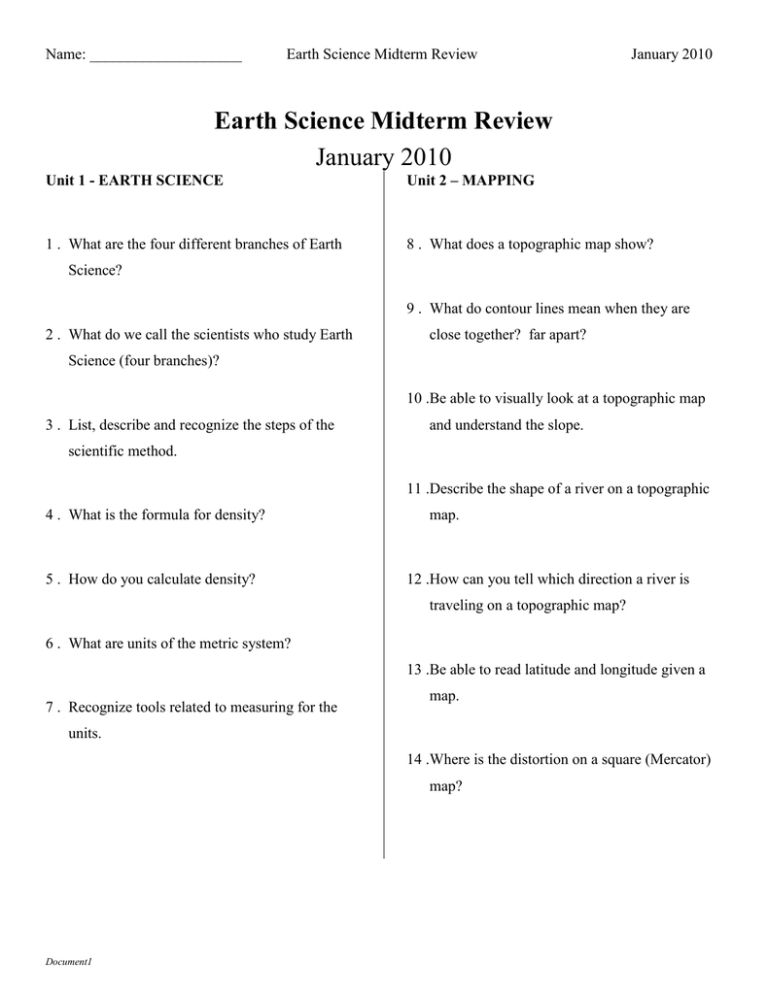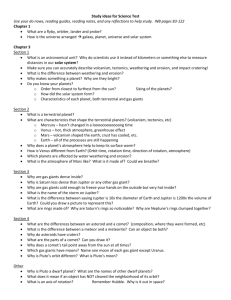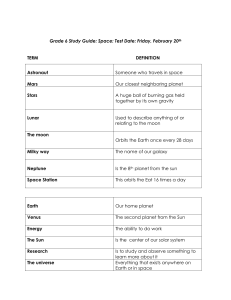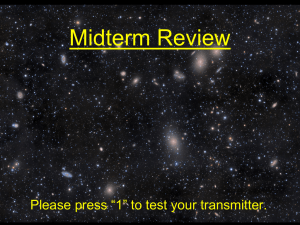Earth Science Midterm Review
advertisement

Name: ____________________ Earth Science Midterm Review January 2010 Earth Science Midterm Review January 2010 Unit 1 - EARTH SCIENCE Unit 2 – MAPPING 1 . What are the four different branches of Earth 8 . What does a topographic map show? Science? 9 . What do contour lines mean when they are 2 . What do we call the scientists who study Earth close together? far apart? Science (four branches)? 10 .Be able to visually look at a topographic map 3 . List, describe and recognize the steps of the and understand the slope. scientific method. 11 .Describe the shape of a river on a topographic 4 . What is the formula for density? 5 . How do you calculate density? map. 12 .How can you tell which direction a river is traveling on a topographic map? 6 . What are units of the metric system? 13 .Be able to read latitude and longitude given a 7 . Recognize tools related to measuring for the map. units. 14 .Where is the distortion on a square (Mercator) map? Document1 Name: ____________________ Earth Science Midterm Review January 2010 Unit 3 – ASTRONOMY Earth/Sun/Moon 15 .What are the types of tides and what causes 24 .What is the reason for the seasons? them? 25 .Define albedo? 16 .What two objects’ gravitational pull affect the tides on Earth? 17 .What is the Earth’s tilt? 26 .How long is Earth’s rotation? 27 .How long is Earth’s revolution? 18 .How does the position of the Earth make it unique to the other planets in our solar system? 28 .Why is the weight of a person different from one planet to another? 19 .What is the one feature on Earth that all living things require to survive? 20 .During which portion of the Earth’s revolution around the sun is the Northern Hemisphere tilted toward the sun? 21 .During which phases of the moon will the tides be highest? 22 .Does the moon have an atmosphere? What is the reason for this? 23 .Why does erosion not occur on the moon? Document1 29 .Recognize a solar and lunar eclipse. 30 .Polaris is the North Star. Explain how it appears to move over the Earth. Why was this star important for ocean navigation 31 .What do we call the material that is thrown out of a crater on the moon? Name: ____________________ Earth Science Midterm Review Stars and the Universe January 2010 42 .What is the shape of the milky way galaxy? 32 .What is a nebula? / What is a nebula composed of? 33 .What is the composition of a comet? The Planets 43 .List the planets in order starting closest to the sun. 34 .What happens to a comet as it gets close to the sun? 35 .Why does a comet’s tail point away from the Sun? 36 .Why do stars appear to change position during the night? 37 .What element is the main component of most stars? 38 .Who is Edwin Hubble and what is his contribution to telescopes? 39 .What is retrograde motion? 44 .Where is the asteroid belt located? 45 .Which planet is sometimes called Earth’s Twin? 46 .What planet has the smallest diameter and the greatest average density? 47 .Which planets travel the fastest around the sun and why? 48 .Which planets have the fastest daily rotation on their axis? 49 .Why does a planet appear brighter than a star in the sky? 40 .Is all matter in the universe stationary or moving? 41 .How do we measure the brightness of a star? 50 .Does a planet produce it’s own light? 51 .Which planet has a fierce hurricane-like storm that is several times the size of Earth? Document1 Name: ____________________ Earth Science Midterm Review January 2010 Unit 4 – Atmosphere/Weather 52 .What tools can be used to measure weather? 64 .How does the ozone protect the Earth? 53 .List the steps of the water cycle. 65 .How does the Greenhouse effect occur? 54 .What happens when a cold front comes into an area? 66 .What effect does the hole in the ozone layer have on the Earth? 55 .Where do most hurricanes form? 67 .How does a cloud form? 56 .What is the main energy source for a hurricane? 68 .What is the dew point? 57 .Reading a barometer. What happens when a barometer rises? falls? 58 .What happens when a warm front comes into an area? 59 .Draw the map symbol for a cold and warm front. 60 . What are isobars? 61 .What is global climate change (warming) and what is the effect on the polar ice cap and the global water level? 62 .What does cloud cover do to the energy absorbed by the Earth during the day? 63 .What do released CFCs and similar compounds do to the atmosphere? Document1 69 .What are land and sea breezes 70 .What is fog? Where is it likely to form? 71 .Why does a desert form near a mountain range and a large body of water? 72 .What countries produce high levels of CO2 and why? 73 .What is the role of ozone in the atmosphere? 74 .What are the layers of the atmosphere (in order)?









